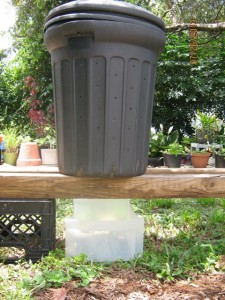
Trash can composting is an effective way to compost at home without spending a ton of money on a compost tumbler or big clunky compost bin.
Are the results as good?
With attention to a few key factors, the answer is definitely yes.
For composting to work well, you need to primarily pay attention to airflow, volume, moisture, and contents.
The above picture was sent in to me, and I love it. Up to this point, I’ve composted in cramped spaces using small kitty litter buckets, but haven’t had a trash can to try.
Realistically, it’s about the same footprint and you’ll get better results due to the capacity.
For a successful trash can composter, make sure you drill plenty of holes- composting needs oxygen. Lots of commercially available composting systems have poor ventilation, and that’s why people complain they have soggy materials inside.
Drill holes in the bottom, too- it’s good for airflow, and also for drainage. It helps to put the trash can up on a pair of cinder blocks or bricks, and place a tray/bucket underneath to catch all the leachate. When this fills up, just dump it back in.
Leachate has nutrients in it, and you might as well put them back in the system. Further, to prevent leachate from running out like crazy, make sure you start the composter with a good six inches of shredded brown materials like leaves, straw, or hay in order to absorb the excess.
After that, just go back and forth between brown and green materials. It also helps to add a handful of browns with each deposit of food scraps to balance it out.
Do you have experience composting like this? Let me know how it’s been.
It’s definitely a cheap and easy way to compost when you don’t have a lot of space but can’t stand throwing “away” your organic materials to the landfill.
